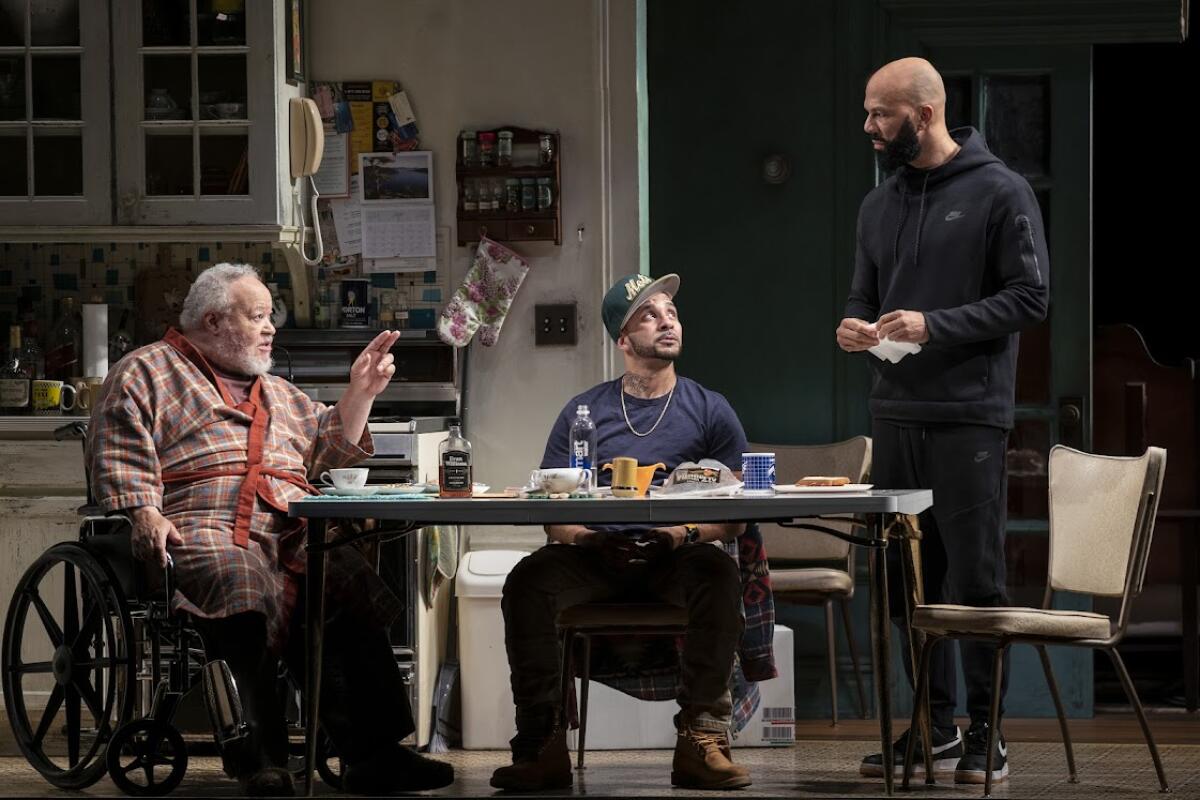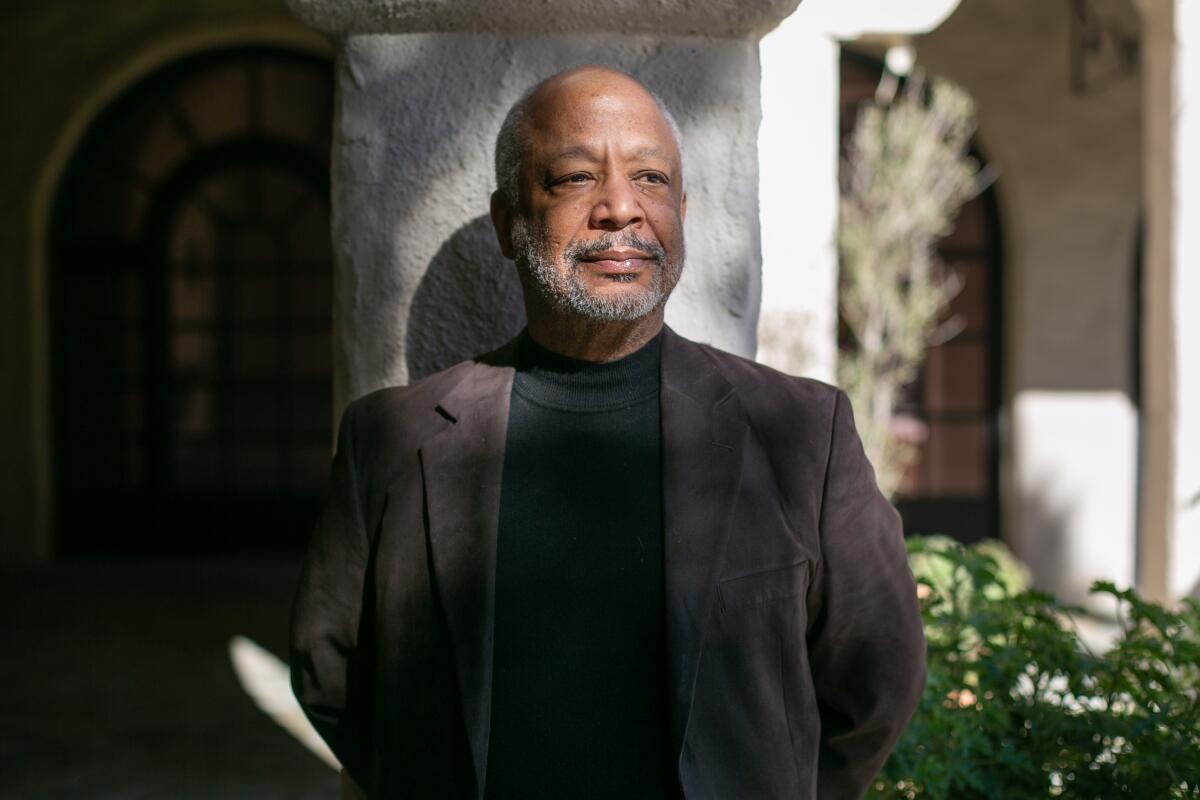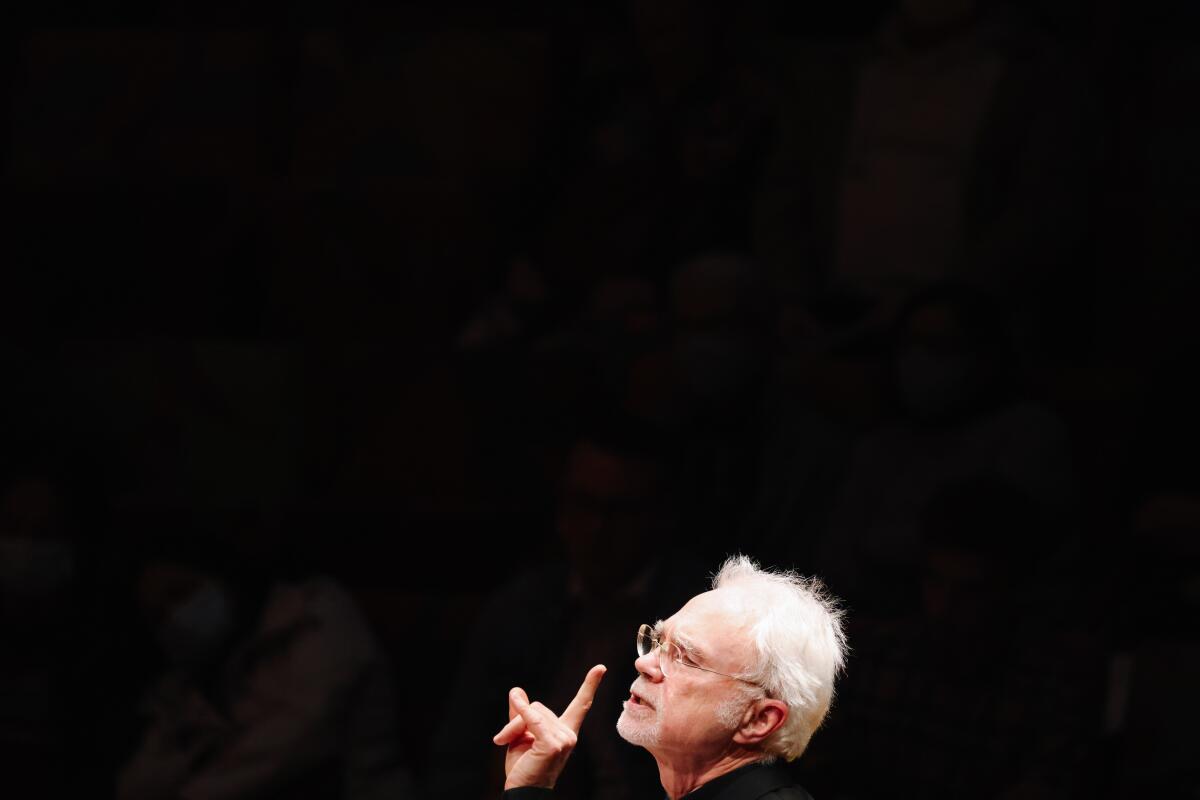Broadway digital theater streaming takes a huge leap forward — and it’s here to stay

- Share via
Good morning. I’m Times theater critic Charles McNulty, filling in for Times arts and design columnist (and Essential Arts newsletter powerhouse) Carolina Miranda. It’s still cold outside, even in sunny Southern California, but the new arts season is heating up. Before surveying this last busy week, I wanted to share some good news for those who’d occasionally like to access Broadway theater from the comfort of home.
Keeping theater’s digital hopes alive
Interest in digital theater has largely subsided now that in-person performance is more or less back in full swing. Is anyone really surprised?
Plays and musicals are meant to be experienced in the theater, not on the couch while you’re simultaneously ordering food, answering texts and scrolling through Instagram. And anyway, how much more screen content can any of us take? As my mother used to shout when I was holed up in my room all day, “Go out — it will be good for you!”
But one group is keeping theater’s digital hopes alive. The League of Live Stream Theater (LOLST), a newly formed nonprofit organization, is collaborating to bring nonprofit Broadway and the best of regional theater into homes, schools and community centers.
The inaugural offering is a welcome one for those who have been unable to attend the Broadway production of “Between Riverside and Crazy,” Stephen Adly Guirgis’ Pulitzer Prize-winning drama, which is nearing the end of its run at the Hayes Theater. Livestream tickets have been made available from Jan. 31 through Feb. 12 at the reasonable price of $68 — a bargain if you consider that a single purchase could reach an entire living room of people.
I saw the production on Tuesday, the streaming premiere. It was the first digital performance that I’ve attended since the Broadway production of Lynn Nottage’s “Clyde’s” was streamed last year.
Second Stage Theater, one of the nonprofit theaters with a Broadway home, produced both plays. And the success of “Clyde’s” inspired the launch of LOLST, which was founded by Jim Augustine, former COO of Zuckerberg Media, and Oren Michels, a Second Stage Theater board member.
According to Katie McKenna, a marketing and development executive at LOLST, Augustine “built the teams and technology necessary to livestream ‘Clyde’s’” and Michels “was integral in negotiating the deal and championing the project.” They reconnected to form their own live streaming nonprofit and, to judge by their debut offering, I am prepared to say that Broadway streaming is here to stay.
The technology has noticeably improved since “Clyde’s.” The simulcast is less glitchy, the camerawork more assured and the video image sharper.
McKenna confirmed my experience: “The simulcast of ‘Between Riverside and Crazy’ offers a higher-resolution streaming experience, a more streamlined ticketing process and native casting to TVs through Airplay and Chromecast. We’re also proud to be able to stream internationally this year and have already welcomed our first audiences from around the world.”
I wasn’t able to fit in “Between Riverside and Crazy” when I was in New York last year for the holidays. I had already seen the play off-Broadway in 2015 after the Atlantic Theater Company production transferred to Second Stage Theater. I also reviewed the Fountain Theatre production in 2019, so the work was relatively fresh in my memory. Still, I regretted not being able to catch the Broadway run.
First and foremost, I wanted another encounter with Guirgis’ award-winning play about a retired Black police officer who left the force after he was shot by another officer in what appears to be a racist incident. The work is so richly imagined, the characters so fully developed, the language so slangily exact and the drama so spiritually probing that it only seems to grow richer with each experience.
Then there’s the magnificence of Stephen McKinley Henderson’s performance of Walter (“Pops”) Washington, the embittered yet endearing patriarch, who sits enthroned in his deceased wife’s wheelchair in his palatial rent-controlled apartment on Riverside Drive. Like a King Lear of the far Upper West Side, he fulminates against the city, which is threatening him with eviction if he doesn’t settle his civil suit, and the injustice of a society that always expects him to bend.
Henderson, one of the most esteemed interpreters of the work of August Wilson, is a national treasure. A supporting actor with a seismic naturalness, he finally has the lead Broadway role he deserves. Having seen him off-Broadway breathe life into this complex and contradictory character, who believes that “doing the wrong thing to do the right thing” is sometimes necessary, I knew that he would be delivering one of the most formidable performances of the Broadway season, and he didn’t disappoint.
Not every stage actor can bear the scrutiny of the camera. But Henderson’s forceful presence gains strength in closeup, his craggy realism never missing a tenderly ferocious beat. A Tony nomination is inevitable and a win would settle accounts.
There’s one other notable cast member in this Broadway production. Common, who taps into deep filial emotion in his Broadway debut, has been cast as Junior, Pops’ son, who after a stint in prison, is living back at home with his girlfriend, Lulu (Rosal Colón), and fellow ex-con Oswaldo (Victor Almanzar), all of them looking to Pops for fatherly support and guidance.
My attention is admittedly less reliable when I’m watching theater at home, but I was locked in as soon as I connected my laptop to my television. This livestream offering is appointment viewing, meaning you can’t hit pause, run a batch of errands and pick up the drama when you’re in the mood again.
You must commit, and this seems to me an essential ingredient in the success of digital theater. I felt a part of the audience that was at the Hayes on Tuesday, even if the sight of masked theatergoers fidgeting with their phones and bulky winter garments before the show made me feel like I had the best seat in the house.
But I’m not at all worried that digital will replace in-person performance. I know the difference in feeling and in connection when you’re shoulder to shoulder with strangers, collectively taking in an artist’s vision.
The LOLST is attempting to expand, enhance and enrich, rather than supplant, the traditional theatergoing experience. In his brief remarks before the show, Augustine laid out the goals of his operation.
“Our mission,” he explained, “is to make Broadway and regional theater more accessible than ever before, by driving new audiences to new works, increasing awareness for world-class stages and artists, and helping these nonprofit institutions thrive for another generation.”
These sentiments were echoed by cast members in the post-show discussion that followed. Almanzar expressed gratitude that family in the Dominican Republic would be able see his Broadway debut. And Common, though he admitted to being initially skeptical, acknowledged that broader access is a net gain.
I too have been skeptical about digital theater, but this smart new venture is opening my mind. Godspeed to the League of Live Stream Theater in bringing the best of American theater to the wider world.
Livestream tickets for “Between Riverside and Crazy” can be obtained here.
Make the most of L.A.
Get our guide to events and happenings in the SoCal arts scene. In your inbox once a week.
You may occasionally receive promotional content from the Los Angeles Times.
On the stage

In other theater news, Times arts and culture writer Jessica Gelt sat down with Sheldon Epps, former artistic director of Pasadena Playhouse, to discuss his recently published memoir, “My Own Directions: A Black Man’s Journey in the American Theatre.” Epps, unflinchingly honest about the challenges he faced as a Black artistic leader of a major nonprofit theater, expresses concern that a new generation of Black leaders is not being given the support needed to thrive. COVID and the racial and cultural reckonings may have unsettled the societal landscape, but his fear is that the groundswell of activism and empowerment will turn out to be “a moment and not a movement.”
I’m happy to report that my drive to and from San Diego on Sunday didn’t provoke the usual violent imprecations at the SoCal highway gods. I arrived for my matinee at the Old Globe Theatre in two hours flat, and my return home was nearly as quick.
Unfortunately, Mary Zimmerman‘s revival of “The Notebooks of Leonardo da Vinci,” the acrobatic performance work that launched her national reputation in the mid-‘90s, lacked the theatrical color of her later work. The mind of Leonardo, Renaissance polymath of boundless curiosity, is endlessly fascinating. But the production was too fragmented to sustain a path of dramatic interest.
I also reviewed Circle X Theatre Co.‘s production of “Do You Feel Anger?,” Mara Nelson-Greenberg’s wild and weird workplace comedy about an empathy coach hitting a brick wall of male toxicity at a debt collection agency that rewards bad behavior. The play, a zany farce that shifts into a more character-centered comedy, is at cross-purposes with itself. But perhaps that is the point: “These women’s workplace situation,” I write, “would be laughable were it not so damn cruel and sad.”

In the galleries
“Ready your comfiest shoes, flounciest outfits and edgiest eyewear — it’s art fair season,” writes Times arts and culture writer Deborah Vankin, who has the ultimate guide to L.A.’s February 2023 art fair bonanza, which includes L.A. Art Show, Felix, Spring/Break Art Show and Frieze Los Angeles. “The 2023 season will be bigger than ever,” Vankin writes, “with more international participants, full visitor capacity and one new fair added to the mix”: Photo Forward Los Angeles, whose mission is to “start conversations around photographic arts, shine a spotlight on galleries specializing in photography and hopefully sell some work.”
Vankin also reports on the progress with Destination Crenshaw, the 1.3 mile public art corridor on Crenshaw Boulevard “reflecting and celebrating Black Los Angeles.” The project‘s “jewel in the crown,” Sankofa Park, is scheduled to debut this fall. Vankin reports that the project will add “4 acres of green space to the area, including nine ‘pocket parks.’ Several of these parks will feature sculptures by Alison Saar, Melvin Edwards and Brenna Youngblood. Five of the pocket parks will debut in December; the other four will open in 2024.” Given the pandemic circumstances, Destination Crenshaw President and COO Jason W. Foster is heartily encouraged: “To come out of that, with the progress we’ve made, and to be finishing Sankofa Park this year allows us to say not only did our aspirations come to life, but we have something here that will be here moving forward.”
The indefatigable Vankin also has an obituary of Walter Ulloa, “media mogul and prolific art collector” who was a tireless advocate for Latinx culture. Ulloa, “a prolific collector of Chicano and Mexican” art, died of sudden heart failure on Dec. 31 at age 74.
Contributor Christina Catherine Martinez reviews Elliott Hundley’s “Echo” exhibition at Regen Projects, writing that she can’t remember the last time she “had this much fun looking at painting, assemblage, ceramics, collage, etc.” Wandering through “a series of different chambers courting different kinds of attention,” Martinez finds that Hundley’s careful interest in his myriad materials fuels her own “pleasure in looking, of paying attention to his attention.”
Nadya Tolokonnikova, founding member of the punk-feminist collective Pussy Riot, had a weeklong exhibition, “Pussy Riot: Putin’s Ashes,” at Jeffrey Deitch gallery. Contributor Steve Appleford interviewed Tolokonnikova, who fearlessly takes aim at Russian president Vladimir Putin in a show that imagines his mausoleum. “I’m talking about Putin’s death,” she tells Appleford. “It’s a dangerous topic to talk about. ... I’ve seen numerous people who pose as punk rockers, but they would not even appear with me in the same picture because they would be scared of their tour getting canceled in Russia or their ticket sales are going to be lower in Russia. Just ridiculous.”
Enjoying this newsletter? Consider subscribing to the Los Angeles Times
Your support helps us deliver the news that matters most. Become a subscriber.
Classical music

In his review of John Adams’ California Gold Rush opera “Girls of the Golden West,” which Adams conducted himself last weekend with the Los Angeles Philharmonic at Walt Disney Concert Hall, classical music critic Mark Swed declares that the work has finally found its operatic gold in a leaner version. Adams, who worked on the revision without original co-creator Peter Sellars, “has cut and connected expertly. The Disney concert performance, for which the singers stood at music stands behind the orchestra, not acting, went straight for the gut.”
Swed also profiled Julia Bullock, who performed in “Girls of the Golden West” and has served as a “muse” to Adams. Listening to her first solo recording, “Walking in the Dark,” Swed hears in this “resonant soprano” “hints of Nina Simone, Lorraine Hunt Lieberson and, in its intensity and presence, Maria Callas.” Oration, the fight of words, matters to Bullock. “By the end of the recording,” Swed writes, “you just may feel the world ever so slightly differently, with your perception a little changed, your receptivity a little enhanced, your sense of wonder a little improved.”
Essential Culture
Steven Vargas once again has in his latest L.A. Goes Out newsletter the best cultural playlist. The calendar of events includes Regeneration Summit: A Celebration of Black Cinema at the Academy Museum of Motion Pictures and “Try/Step/Trip,” a piece by Dahlak Brathwaite at the Wallis Annenberg Center for the Performing Arts that combines spoken word, hip-hop and theater.
And for more guidance for your cultural week, listings coordinator nonpareil Matt Cooper identifies the most compelling happenings in your own neighborhood.
Moves
As if an influx of out-of-town galleries visiting L.A. for next week’s art fairs wasn’t enough, there are also several new galleries opening — or existing ones expanding — in L.A. right now.
This Saturday, Feb. 4, downtown L.A.’s François Ghebaly gallery will preview a new, second space. The 3,000-square-foot West Hollywood gallery will debut with an exhibition of work by Patrick Jackson in an unrenovated space. The show will close March 4, at which point the gallery will renovate and reopen later this year or next. 1109 North Poinsettia Place.
Design destination Twentieth is moving from its urban Beverly Boulevard location to a wooded retreat in the Hollywood Hills. It will feature 5,000 square feet of indoor exhibition space along with sculpture gardens on an acre of land. It opens Feb. 13 with the exhibition “ERODE – MORPH – BLOOM.” 7728 Woodrow Wilson Drive.
L.A.’s Hauser & Wirth, a staple of the downtown Arts District, will debut a West Hollywood location on Feb. 15 with an exhibition of work by George Condo. The former vintage car showroom will feature 5,000 square feet of exhibition space, about a quarter of Hauser & Wirth’s downtown exhibition space. 8980 Santa Monica Blvd.
Lisson Gallery — which has locations in London and New York as well as several in China — will debut a 8,000-square-foot L.A. gallery on Sycamore Boulevard in Hollywood on April 15. The first exhibition will feature work from the 1970s by the late artist Carmen Herrera. 1037 N. Sycamore Ave.
Finally, the digital art site Tappan Collective is opening a bricks-and-mortar gallery in West Hollywood on Feb. 16. Its 2,500 square feet of exhibition space will be dedicated to emerging artists. 8200 Melrose Ave.
The L.A. Phil has announced the creation of the California Festival, headed by conductors Gustavo Dudamel, Esa-Pekka Salonen and Rafael Payare, that will serve as a kind of musical art fair, allowing orchestra up and down the state to present whatever new music they see fit.
Pasadena Now reports that the former music director of the Pasadena Symphony, David Lockington, is suing the orchestra for religious discrimination over his dismissal for refusing to be vaccinated for COVID-19.
The Dorris Staples Theatrical Conservatory announced that it will launch a program this summer at the California Center for the Arts, Escondido, to provide access to and create pathways for careers in all aspects of theatrical production for limitless communities.
The 2023 Creative Capital “Wild Futures: Art, Culture, Impact Awards” has bestowed grants totaling $2.5 million for 50 projects, funding 66 individual artists working in technology, the performance arts, literature, as well as multidisciplinary and “socially engaged” activities.
The Old Globe in San Diego has received a $25,000 Humanities for All Grant to support the theater’s Shakespeare for All project, a citywide series of free humanities events as part of its Henry 6 project for the summer of 2024.
In other news
- No, those luxury apartment owners near the Tate Modern won’t be on exhibition anymore now that the U.K.’s highest court has ruled in favor of their privacy.
- Tony voters no longer have to see every show in a category to cast a vote, relieving some guilt for those busy Tony voters who regularly cast votes regardless of the persnickety rules.
- California Gov. Gavin Newsom has proposed cutting $1.2 billion of one-time discretionary funding for arts and instructional materials in his pared-back 2023-24 state budget, but would you believe it’s not as bad as it sounds?
And last but not least ...
My colleague Jessica Gelt passed along to me A.O. Scott’s excellent essay on the ethics of watching the footage of Memphis police officers beating Tyre Nichols. I haven’t been able to watch, but I’ve heard the harrowing audio on the news and have been struggling to figure out my moral duty. Scott asks us to consider the line between witnessing and spectatorship and urges us to contemplate our own complicity, which is where, he concludes, “the work of watching these videos should begin.”
The biggest entertainment stories
Get our big stories about Hollywood, film, television, music, arts, culture and more right in your inbox as soon as they publish.
You may occasionally receive promotional content from the Los Angeles Times.




